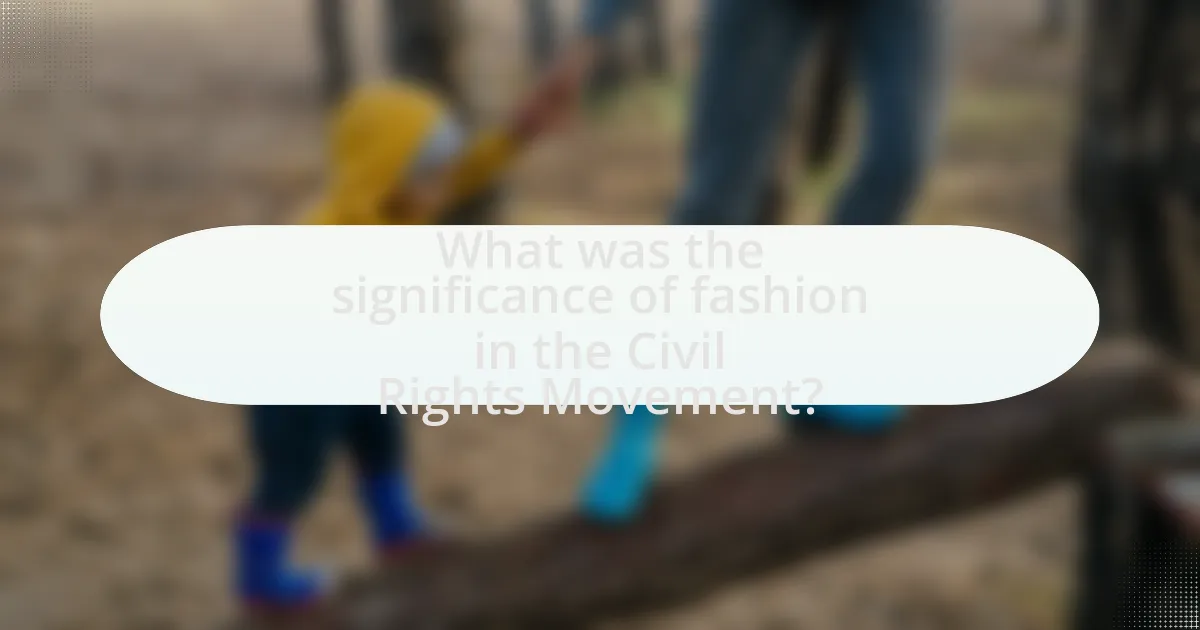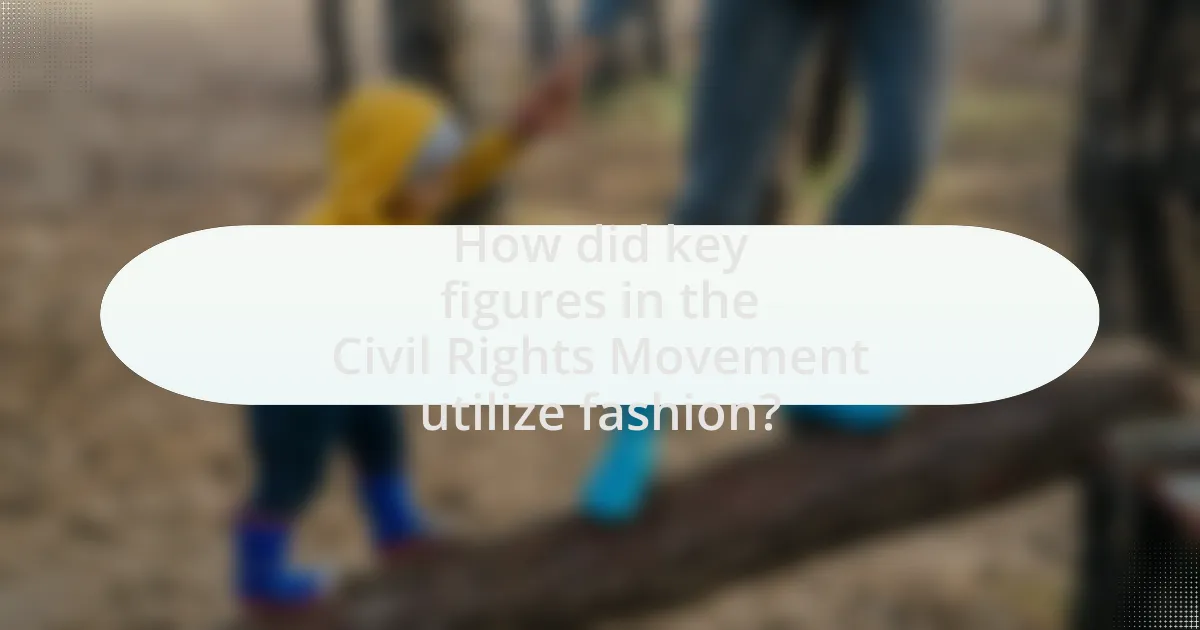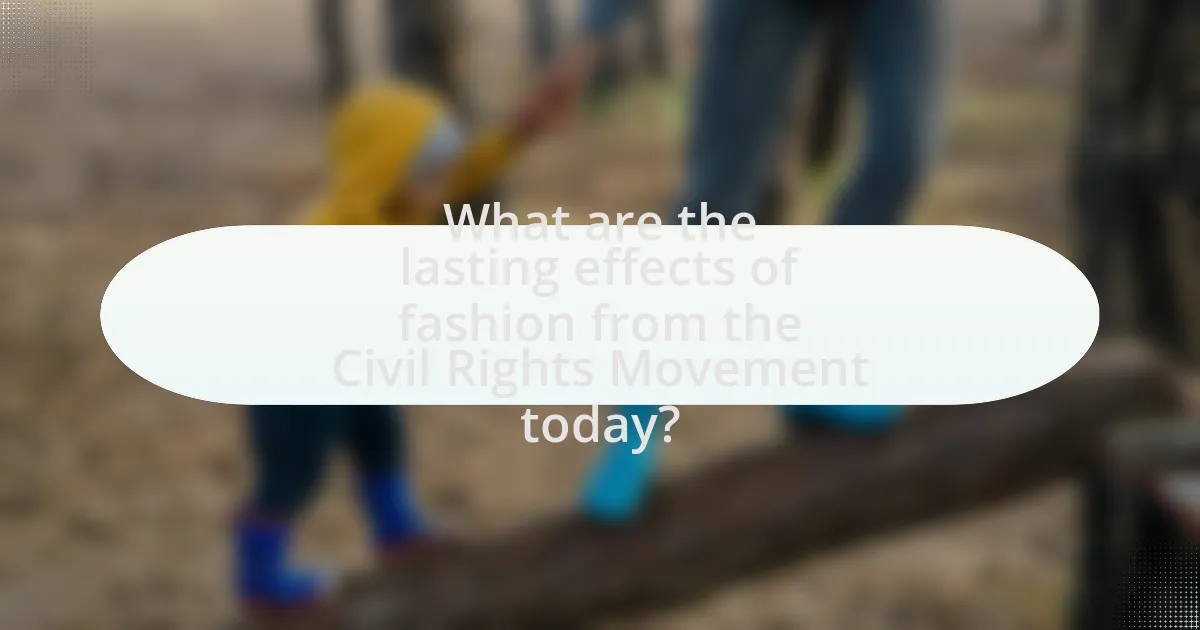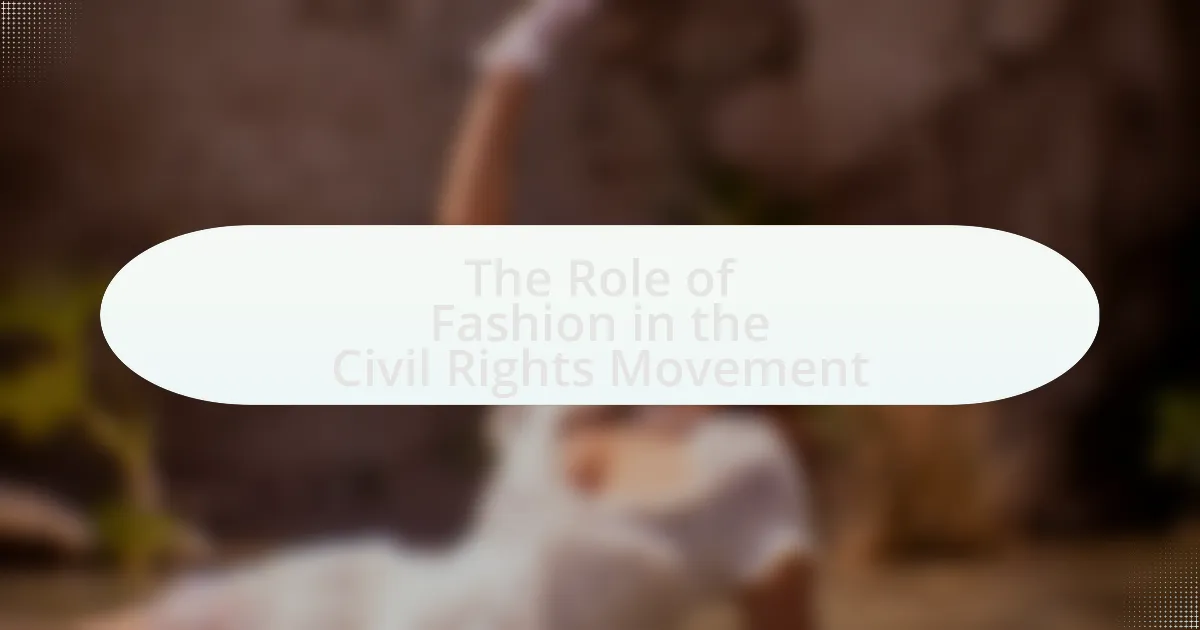The article examines the significant role of fashion in the Civil Rights Movement, highlighting how clothing choices served as expressions of identity, dignity, and resistance among activists. It discusses specific clothing items that became symbols of empowerment, such as the black beret and the African dashiki, and how these styles fostered unity and solidarity within the movement. The article also explores the impact of fashion on public perception, media representation, and the ongoing influence of these historical fashion choices on contemporary activism and social justice movements. Key figures like Martin Luther King Jr. and Malcolm X are analyzed for their intentional use of fashion to convey messages of professionalism and strength, while the article emphasizes the lasting legacy of fashion as a tool for social change.

What was the significance of fashion in the Civil Rights Movement?
Fashion played a significant role in the Civil Rights Movement by serving as a form of expression and identity for activists. The clothing choices made by individuals, such as the use of tailored suits and dresses, symbolized dignity and respectability, countering negative stereotypes associated with African Americans. For instance, during the 1963 March on Washington, participants wore formal attire to convey their seriousness and commitment to the cause, which helped to garner respect from the media and the public. Additionally, fashion was used to promote unity and solidarity, as seen in the adoption of specific styles like the black beret by the Black Panther Party, which became a symbol of resistance and empowerment. These fashion choices not only reflected the values of the movement but also influenced broader societal perceptions of race and equality.
How did fashion serve as a form of protest during the Civil Rights Movement?
Fashion served as a form of protest during the Civil Rights Movement by allowing individuals to express their identity and resistance against racial oppression. Activists utilized clothing styles, such as the adoption of African-inspired garments and the wearing of specific colors, to symbolize unity and in Black culture. For instance, the Black Panther Party members wore uniforms that conveyed strength and solidarity, while the use of traditional African attire during protests highlighted a reclamation of heritage. These fashion choices were not merely aesthetic; they were deliberate acts of defiance against systemic racism and a means to foster community among activists.
What specific clothing items became symbols of resistance?
Specific clothing items that became symbols of resistance during the Civil Rights Movement include the black beret, denim overalls, and the African dashiki. The black beret was notably worn by members of the Black Panther Party, symbolizing solidarity and empowerment. Denim overalls were adopted by activists as a practical yet defiant choice, representing working-class identity and resistance to oppression. The African dashiki emerged as a vibrant expression of African heritage and , challenging Eurocentric beauty standards and promoting cultural identity. These items collectively served as powerful visual statements against racial injustice and inequality.
How did individuals use fashion to express their identity and beliefs?
Individuals used fashion as a powerful medium to express their identity and beliefs during the Civil Rights Movement by adopting styles that symbolized resistance, unity, and cultural . For instance, the adoption of African-inspired clothing, such as dashikis and kente cloth, served to celebrate African heritage and assert a distinct identity in the face of systemic racism. Additionally, the use of specific colors, like black and red, in clothing choices was often linked to political movements and solidarity among activists. Historical events, such as the 1963 March on Washington, showcased individuals wearing coordinated outfits to convey a collective message of equality and justice. This strategic use of fashion not only reflected personal beliefs but also fostered a sense of community and purpose among participants in the movement.
Why was fashion important for the visibility of the Civil Rights Movement?
Fashion was important for the visibility of the Civil Rights Movement because it served as a powerful tool for self-expression and identity among activists. The clothing choices made by figures such as Martin Luther King Jr. and Rosa Parks conveyed messages of dignity, resistance, and unity, which helped to attract media attention and public support. For instance, the use of tailored suits and dresses during protests symbolized respectability and challenged prevailing stereotypes about African Americans. This strategic use of fashion not only enhanced the movement’s visibility but also played a crucial role in shaping public perception and fostering solidarity within the community.
How did media coverage of fashion influence public perception?
Media coverage of fashion significantly influenced public perception by shaping societal norms and ideals regarding race, identity, and empowerment during the Civil Rights Movement. Fashion media highlighted the styles and expressions of African American culture, promoting figures like Angela Davis and the Black Panther Party, which helped to redefine beauty standards and challenge racial stereotypes. For instance, the portrayal of the Afro hairstyle in magazines and television not only celebrated Black identity but also became a symbol of resistance against oppression. This visibility in media contributed to a broader acceptance and appreciation of diversity in fashion, ultimately impacting public attitudes towards race and equality.
What role did fashion play in the representation of African American culture?
Fashion served as a powerful medium for the representation of African American culture by expressing identity, resistance, and solidarity during the Civil Rights Movement. Through clothing choices, African Americans showcased cultural and challenged racial stereotypes, as seen in the adoption of styles like the Afro hairstyle and vibrant, traditional garments. These fashion statements were not merely aesthetic; they symbolized a collective identity and a rejection of mainstream norms, reinforcing the message of empowerment and unity. Historical events, such as the 1963 March on Washington, highlighted how fashion was used to convey dignity and purpose, with participants often dressing in their best attire to assert their humanity and demand civil rights.

How did key figures in the Civil Rights Movement utilize fashion?
Key figures in the Civil Rights Movement utilized fashion as a means of expressing identity, solidarity, and resistance against racial oppression. For instance, leaders like Martin Luther King Jr. and Malcolm X often wore tailored suits, which conveyed professionalism and dignity, challenging stereotypes of African Americans. Additionally, the use of specific colors and symbols, such as the black beret worn by the Black Panther Party, served to unify members and signify their political stance. The fashion choices made by these leaders were intentional, aiming to project strength and unity while also drawing attention to the movement’s goals.
Who were the influential figures that shaped fashion trends during this era?
Influential figures that shaped fashion trends during the Civil Rights Movement include Angela Davis, James Baldwin, and Malcolm X. Angela Davis popularized the Afro hairstyle and advocated for Black through her fashion choices, which included bold colors and styles that reflected her political beliefs. James Baldwin, known for his literary contributions, also influenced fashion by promoting a sophisticated, tailored aesthetic that challenged racial stereotypes. Malcolm X’s iconic look, characterized by sharp suits and glasses, became a symbol of empowerment and resistance. These figures not only impacted fashion but also used their style as a means of expressing their activism and identity during a pivotal era in American history.
What styles did leaders like Martin Luther King Jr. and Malcolm X promote?
Martin Luther King Jr. promoted a style characterized by formal attire, often wearing suits and ties, which symbolized dignity and respectability in the fight for civil rights. This choice of clothing was intended to convey a message of professionalism and moral authority, aligning with his philosophy of nonviolent resistance. In contrast, Malcolm X embraced a more militant style, often seen in sharp suits and sometimes a black beret, which reflected his advocacy for self-defense and empowerment within the African American community. His fashion choices were designed to project strength and assertiveness, aligning with his message of black nationalism. Both leaders used their clothing to communicate their ideologies and to influence public perception during the Civil Rights Movement.
How did women in the movement use fashion to assert their roles?
Women in the Civil Rights Movement used fashion to assert their roles by adopting styles that symbolized empowerment and resistance. For instance, many women wore tailored suits and dresses that conveyed professionalism and dignity, countering stereotypes of African American women. Additionally, the use of traditional African attire and vibrant colors served to celebrate cultural heritage and assert identity in a predominantly white society. This strategic use of fashion not only challenged societal norms but also fostered a sense of unity and purpose among activists, as seen in events like the March on Washington in 1963, where women prominently showcased their fashion choices to make a statement about their place in the movement.
What impact did fashion choices have on the movement’s messaging?
Fashion choices significantly influenced the messaging of the Civil Rights Movement by serving as a visual representation of identity, unity, and resistance. For instance, the adoption of African-inspired clothing and hairstyles, such as the Afro, symbolized in Black heritage and a rejection of Eurocentric beauty standards. This choice communicated a powerful message of cultural affirmation and solidarity among activists. Additionally, the use of specific attire, like the black beret worn by members of the Black Panther Party, conveyed a sense of militancy and empowerment, reinforcing their commitment to social justice. These fashion statements were not merely aesthetic; they were strategic tools that helped articulate the movement’s goals and foster a collective identity among participants.
How did clothing choices reflect the values of the movement?
Clothing choices during the Civil Rights Movement reflected the values of dignity, unity, and resistance against oppression. Activists often wore simple, modest attire, such as suits and dresses, to convey respectability and challenge stereotypes associated with African Americans. For instance, during the 1963 March on Washington, participants donned formal clothing to emphasize their demand for equality and justice, showcasing a commitment to nonviolent protest and civil discourse. This choice of attire served as a visual statement against the prevailing social norms that marginalized their identity, reinforcing the movement’s core values of empowerment and solidarity.
What messages were conveyed through specific fashion statements?
Specific fashion statements during the Civil Rights Movement conveyed messages of resistance, identity, and solidarity. For example, the use of African-inspired clothing, such as dashikis, symbolized a reclaiming of African heritage and , contrasting with mainstream Western fashion. Additionally, the adoption of the black beret by groups like the Black Panthers communicated a unified stance against oppression and a call for social justice. These fashion choices were not merely aesthetic; they served as powerful visual declarations of political beliefs and cultural identity, reinforcing the movement’s goals and fostering a sense of community among activists.

What are the lasting effects of fashion from the Civil Rights Movement today?
The lasting effects of fashion from the Civil Rights Movement today include the promotion of cultural identity and social justice through clothing choices. Fashion during the Civil Rights Movement, such as the adoption of African-inspired styles and the use of clothing as a form of protest, has influenced contemporary fashion by encouraging expressions of individuality and activism. For instance, the Black Lives Matter movement has seen participants wearing clothing that symbolizes resistance and solidarity, echoing the historical use of fashion as a political statement. Additionally, designers today often draw inspiration from the aesthetics of the Civil Rights era, integrating elements that reflect the struggle for equality and empowerment, thereby keeping the legacy of that movement alive in modern fashion.
How has the legacy of fashion in the Civil Rights Movement influenced modern activism?
The legacy of fashion in the Civil Rights Movement has significantly influenced modern activism by using clothing as a powerful tool for identity and solidarity. Activists today often adopt styles reminiscent of the Civil Rights era, such as the black beret or the use of specific colors, to symbolize their commitment to social justice causes. For instance, the Black Lives Matter movement has utilized fashion to create a sense of unity and purpose, similar to how the Civil Rights Movement employed clothing to convey messages of resistance and empowerment. Historical examples include the use of tailored suits by leaders like Martin Luther King Jr. to project dignity and respect, which continues to inspire contemporary activists to dress purposefully to make statements about their causes.
What contemporary movements draw inspiration from the fashion of the Civil Rights era?
Contemporary movements that draw inspiration from the fashion of the Civil Rights era include Black Lives Matter and various social justice initiatives advocating for racial equality. These movements often reference the bold styles and statements made by activists during the Civil Rights Movement, such as the use of African-inspired patterns, tailored suits, and the iconic black berets worn by groups like the Black Panther Party. The fashion choices of that time symbolized resistance and empowerment, which contemporary activists adopt to convey similar messages of solidarity and activism in their own campaigns.
How do current fashion trends reflect the ongoing struggle for civil rights?
Current fashion trends reflect the ongoing struggle for civil rights by incorporating symbols, messages, and styles that advocate for social justice and equality. For instance, the resurgence of clothing featuring slogans like “Black Lives Matter” and designs inspired by cultural heritage highlights the intersection of fashion and activism. This trend is evident in the work of designers such as Virgil Abloh and brands like Pyer Moss, which intentionally address racial inequality and celebrate Black culture through their collections. Additionally, the use of fashion as a platform for protest, seen in events like the Met Gala where attendees wear politically charged outfits, underscores the role of style in raising awareness about civil rights issues. These examples illustrate how contemporary fashion serves not only as a means of self-expression but also as a vehicle for promoting civil rights and social change.
What lessons can be learned from the intersection of fashion and activism?
The intersection of fashion and activism teaches that clothing can serve as a powerful medium for social change and identity expression. Historical examples, such as the Black Panther Party’s use of uniforms, illustrate how fashion can convey solidarity and political messages. Additionally, the Civil Rights Movement utilized specific styles, like the wearing of African-inspired garments, to promote cultural and resistance against oppression. These instances demonstrate that fashion not only reflects societal values but can also mobilize communities and raise awareness about critical issues.
How can individuals use fashion as a tool for social change today?
Individuals can use fashion as a tool for social change today by consciously choosing clothing that reflects their values and promotes awareness of social issues. For instance, wearing garments that feature slogans or symbols related to movements such as Black Lives Matter or climate change can spark conversations and raise awareness. Historical examples, such as the use of clothing by civil rights activists in the 1960s, demonstrate that fashion can serve as a powerful medium for expressing solidarity and advocating for justice. Additionally, brands that prioritize ethical production and sustainability can influence consumer behavior and encourage a shift towards more responsible fashion choices, thereby contributing to broader social change.
What best practices can activists adopt from the Civil Rights Movement’s fashion strategies?
Activists can adopt the best practice of using fashion as a form of identity and solidarity, as demonstrated during the Civil Rights Movement. Activists like Martin Luther King Jr. and Rosa Parks utilized clothing to convey messages of dignity and resistance, often wearing formal attire to challenge stereotypes and assert their humanity. This strategic choice of clothing not only fostered a sense of unity among participants but also communicated their commitment to nonviolence and respectability, which was crucial in gaining public sympathy and support. The use of specific symbols, such as the color black to signify mourning and resistance, further reinforced their message. By consciously selecting attire that reflects their values and mission, contemporary activists can create a powerful visual narrative that resonates with their audience and strengthens their cause.

Leave a Reply